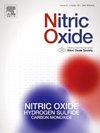Catestatin alleviates PASMC phenotypic switching-mediated pulmonary arterial remodeling in a rat model of MCT-induced pulmonary arterial hypertension by promoting endothelium-derived no synthesis
IF 3.2
2区 生物学
Q2 BIOCHEMISTRY & MOLECULAR BIOLOGY
引用次数: 0
Abstract
Background
Enhancing the nitric oxide (NO) signaling pathway is an effective strategy for treating pulmonary arterial hypertension (PAH). Previous research has found that Catestatin (CST) exerts a negative inotropic effect by upregulating NO production. However, the effect of CST on PAH remains unclear.
Methods
In vivo, PAH was induced in rats by monocrotaline (MCT) injection. After MCT administration, continuous CST treatment was applied to the experimental group. At study conclusion, echocardiographic, hemodynamic, and histological assessments were performed. In vitro, the effects of CST on rat pulmonary arterial endothelial dysfunction and phenotypic switching of rat pulmonary arterial smooth muscle cells (rPASMC) under PAH-like conditions were investigated. The role of NO in rPASMC phenotypic switching was also explored.
Results
In vivo experiments demonstrated that CST significantly improved right heart structure and function in rats with PAH, reduced pulmonary arterial pressure, and alleviated remodeling of the right ventricle and pulmonary arteries. These effects were likely mediated by upregulation of the eNOS/cGMP/PKG pathway. In vitro, CST promoted endothelial NO synthesis via the PI3K/Akt/eNOS pathway, but had no significant impact on the proliferation or migration of rPASMCs. In contrast, exogenous NO effectively inhibited rPASMC phenotypic switching by arresting the cell cycle at the G0/G1 phase.
Conclusion
CST enhances endothelial NO synthesis through the PI3K/Akt/eNOS pathway, which subsequently acts on rPASMCs to inhibit their phenotypic switching via the NO/cGMP/PKG signaling pathway, thereby alleviating pulmonary arterial remodeling in PAH.
Catestatin通过促进内皮源性NO合成,缓解mct诱导的肺动脉高压大鼠模型中PASMC表型转换介导的肺动脉重塑。
背景:增强一氧化氮(NO)信号通路是治疗肺动脉高压(PAH)的有效策略。先前的研究发现Catestatin (CST)通过上调NO的产生而产生负性肌力效应。然而,CST对多环芳烃的影响尚不清楚。方法:在体内用MCT诱导大鼠多环芳烃。实验组在给予MCT后,继续给予CST治疗。在研究结束时,进行超声心动图、血流动力学和组织学评估。体外实验研究了CST对pah样条件下大鼠肺动脉内皮功能障碍及肺动脉平滑肌细胞(rPASMC)表型转换的影响。我们还探讨了NO在rPASMC表型转换中的作用。结果:体内实验表明,CST能显著改善PAH大鼠右心结构和功能,降低肺动脉压,减轻右心室和肺动脉重构。这些作用可能是由eNOS/cGMP/PKG通路的上调介导的。在体外,CST通过PI3K/Akt/eNOS途径促进内皮细胞NO合成,但对rPASMCs的增殖或迁移没有显著影响。相比之下,外源性NO通过阻止细胞周期在G0/G1期有效抑制rPASMC表型转换。结论:CST通过PI3K/Akt/eNOS通路促进内皮细胞NO合成,进而作用于rPASMCs,通过NO/cGMP/PKG信号通路抑制其表型转换,从而缓解PAH肺动脉重构。
本文章由计算机程序翻译,如有差异,请以英文原文为准。
求助全文
约1分钟内获得全文
求助全文
来源期刊

Nitric oxide : biology and chemistry
生物-生化与分子生物学
CiteScore
7.50
自引率
7.70%
发文量
74
审稿时长
52 days
期刊介绍:
Nitric Oxide includes original research, methodology papers and reviews relating to nitric oxide and other gasotransmitters such as hydrogen sulfide and carbon monoxide. Special emphasis is placed on the biological chemistry, physiology, pharmacology, enzymology and pathological significance of these molecules in human health and disease. The journal also accepts manuscripts relating to plant and microbial studies involving these molecules.
 求助内容:
求助内容: 应助结果提醒方式:
应助结果提醒方式:


